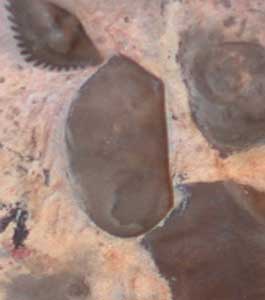
 |
Fossil ostracod. One half of the carapace is visible in this image taken by Karen Osborn of a UCMP specimen. |
Ostracods provide one of the most complete and consistent fossil records of any animal. They appear in the Cambrian, diversify in the Ordivician and are most abundant in the Silurian. They have been studied extensively by micropaleontologists because they are small and easy to obtain. Fossil remains generally consist of the carapace only making fossil forms difficult to compare to living animals. By studying their location and the condition of the carapace, researchers are able to determine water depth, salinity, sedimentation, temperature and other paleoecological factors from when the fossils were living. They are used extensively by the oil industry to indicate potential oil reserves. Sometime ostracod deposits are so extensive they form rocks referred to as coquinas which are often used for building. Coquinas are soft, light colored limestones that are made up of the mineralized remains of animals such as ostracod carapaces, broken shells, coral, and algal remains. The white cliffs of Dover in England are a good example of this type of rock.
